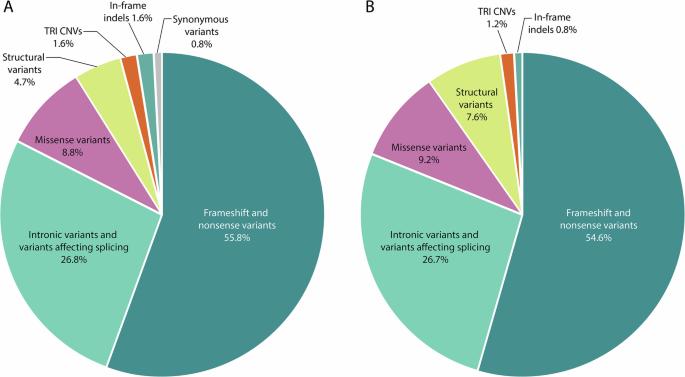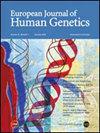星云蛋白的结构变异及其对表型和遗传的影响:建立由大缺失引起的显性远端表型。
IF 4.6
2区 生物学
Q2 BIOCHEMISTRY & MOLECULAR BIOLOGY
引用次数: 0
摘要
星云基因(NEB)的结构变异(SVs),包括基因内重复、缺失和三重复区域的拷贝数变异,是隐性遗传线状肌病和相关神经肌肉疾病的确定原因。大量缺失已被证明会导致显性遗传性远端肌病。在这里,我们对NEB中由此类SVs引起的肌肉疾病的35个家族进行了概述。使用定制的比较基因组杂交阵列、外显子组测序、短读基因组测序、定制的液滴数字PCR或Sanger测序,我们在35个NEB相关肌病家族中鉴定了致病性SVs。在23个家族中,发现了隐性基因内缺失和重复或与疾病分离的复合杂合形式的三重区域的致病增益,以及反式的小变异。然而,在两个家族中,SV是纯合子的。其中8个家族以前没有被描述过。在12个具有远端肌病表型的家族中(其中10个以前未发表),鉴定出8个独特的大缺失,包括52-97个杂合(n = 10)或镶嵌(n = 2)状态的外显子。在隐性遗传的家庭中,变异的类型和疾病的严重程度之间没有相关性。相比之下,所有具有NEB大显性缺失的患者有较轻的,主要是远端肌肉无力。我们首次在NEB大缺失和一种远端肌病之间建立了明确且具有统计学意义的关联。此外,我们还提供了迄今为止NEB中sv光谱的最大概述。本文章由计算机程序翻译,如有差异,请以英文原文为准。

Structural variation in nebulin and its impact on phenotype and inheritance: establishing a dominant distal phenotype caused by large deletions
Structural variants (SVs) of the nebulin gene (NEB), including intragenic duplications, deletions, and copy number variation of the triplicate region, are an established cause of recessively inherited nemaline myopathies and related neuromuscular disorders. Large deletions have been shown to cause dominantly inherited distal myopathies. Here we provide an overview of 35 families with muscle disorders caused by such SVs in NEB. Using custom Comparative Genomic Hybridization arrays, exome sequencing, short-read genome sequencing, custom Droplet Digital PCR, or Sanger sequencing, we identified pathogenic SVs in 35 families with NEB-related myopathies. In 23 families, recessive intragenic deletions and duplications or pathogenic gains of the triplicate region segregating with the disease in compound heterozygous form, together with a small variant in trans, were identified. In two families the SV was, however, homozygous. Eight of these families have not been described previously. In 12 families with a distal myopathy phenotype (of which 10 are previously unpublished), eight unique, large deletions encompassing 52–97 exons in either heterozygous (n = 10) or mosaic (n = 2) state were identified. In the families where inheritance was recessive, no correlation could be made between the types of variants and the severity of the disease. In contrast, all patients with large dominant deletions in NEB had milder, predominantly distal muscle weakness. For the first time, we establish a clear and statistically significant association between large NEB deletions and a form of distal myopathy. In addition, we provide the hitherto largest overview of the spectrum of SVs in NEB.
求助全文
通过发布文献求助,成功后即可免费获取论文全文。
去求助
来源期刊

European Journal of Human Genetics
生物-生化与分子生物学
CiteScore
9.90
自引率
5.80%
发文量
216
审稿时长
2 months
期刊介绍:
The European Journal of Human Genetics is the official journal of the European Society of Human Genetics, publishing high-quality, original research papers, short reports and reviews in the rapidly expanding field of human genetics and genomics. It covers molecular, clinical and cytogenetics, interfacing between advanced biomedical research and the clinician, and bridging the great diversity of facilities, resources and viewpoints in the genetics community.
Key areas include:
-Monogenic and multifactorial disorders
-Development and malformation
-Hereditary cancer
-Medical Genomics
-Gene mapping and functional studies
-Genotype-phenotype correlations
-Genetic variation and genome diversity
-Statistical and computational genetics
-Bioinformatics
-Advances in diagnostics
-Therapy and prevention
-Animal models
-Genetic services
-Community genetics
 求助内容:
求助内容: 应助结果提醒方式:
应助结果提醒方式:


